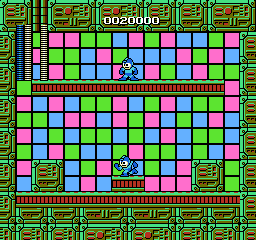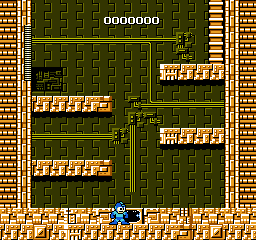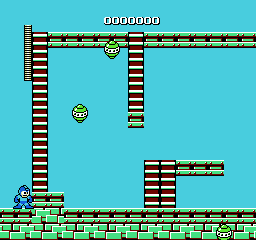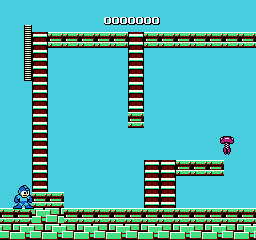Mega Man (NES)
| Mega Man |
|---|
|
Also known as: Rockman (JP, TW, CN)
|
Mega Man is one of the great icons of the NES. This game would go on to found a number of basic principles for 2-D sidescrolling action, and is also considered to be one of the hardest games on the NES. These principles would be better refined in sequels and offshoots, but this is where the little blue robot first got his starts.
Contents
Sub-Pages
| Prerelease Info |
| Bugs |
| Unused Level Data Tiles, Blocks, just remains of construction development! |
Unused Code
The Game Genie code PEXPIIAA (all versions) re-enables a strange bit of unused code: hold A on controller 2 while landing on the ground, and Mega Man will act as though he's been stunned by Guts Man's earthquakes. The purpose of this code is completely unknown, though it may have just been for testing purposes.
Unused Sprites
![]()
Sprites of Dr. Light talking and pointing upwards while wearing colored pants (the used sprite has white pants). They would have fit best in the ending, but really could have been used anywhere.
![]()

Unused tiles found in Guts Man's graphics, intended to be used when he squats down to jump. The image on the right shows how it would've looked.
![]()
Unused sprite for the Kamadoma enemy, showing it standing upright.
![]()
Unused sprite for the Pickelman enemy. It's almost identical to its used throwing sprite, except that the shield is shifted one pixel forward.

Super Cutter has three unused sphere-like details with its tiles. Concept art shows it was planned to have a large body made of spheres, with the cutter being the head. Under the tiles is a mockup of how it would've looked.
![]()
Unknown tiles located between the enemies Pickelman and Watcher.
Unused Background Tiles
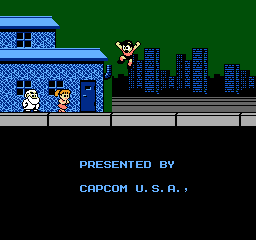
An unused door that would have fit with the house from the ending. Mega Man: The Wily Wars would later add a door to its version of this scene, but it looks quite different, and is even a different shape.
Unseen Title Screen Details
| In-Game | With sprite layer disabled |
|---|---|
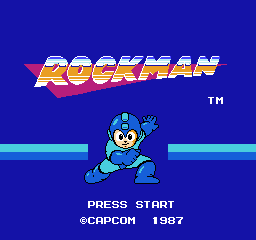 |
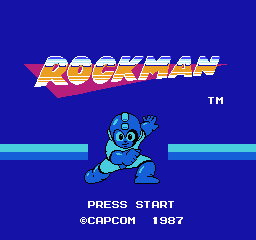 |
Normally, Mega Man's face on the Japanese title screen is a sprite overlay to get around palette limitations, just like on his actual sprite. However, removing the sprite layer reveals that an identical background version is present underneath, using the same palette as the rest of his body (And as such also flashes when pressing Start). As expected, this isn't the case for the international title screen.
Partially Unused Music
| Intended | In-Game |
|---|---|
Part of the jingle heard when selecting a Robot Master is obscured by sound effects, giving the song a noticably different melody in the beginning. Interestingly, the arrangement of the song featured in The Wily Wars is directly based on the in-game version.
Unused Copy Robot Behavior
As the Copy Robot boss in Wily Stage 2 has the same behavior as Elec Man, it has some unused behavior.
Normally, the boss room is a completely flat plain with nothing in the way of either the boss or the player. However, if the room is modified to include solid obstacles (as in the image), the Copy Robot boss will go to its "jump" script when blocked. This jump script is the same one used when the player presses the Fire button, which makes it hop randomly to the left or to the right.
It's also of note that if the player presses Fire while Copy Robot is falling from a higher platform, the "jump" script will still trigger, making it appear as though the Copy Robot is jumping in mid-air.
Unused Level Data
Unused Wily Stage
Elec Man Room IDs $13 ~ $18.
| To do: Get or make a better video. |
Located beyond the end of Elec Man's stage is unused room data. Internally, it has the player go down 1 screen, right 8 screens, then into a boss chamber.
The data contains repeated sectors of Elec Man's stage with what seems to be a segment that looks to have originally belonged in a Wily stage. It can be accessed by changing some pointers in Elec Man's stage (show below), but direct access to this stage segment can also be reached by changing the stage value of $31 to 0A (shown right), suggesting that it was intended to be a fifth Wily Stage. However, in May of 2024, Mega Man director Akira Kitamura confirmed via Twitter that this was not the case.
| Mega Man "Stage 0A" (via Elec Man's Stage) |
|---|

|
| Mega Man Stage Wily Stage 4 (partial) |

|
| Mega Man: Powered Up Wily Stage 4 (mockup) |

|
By coincidence or intent, the fourth Wily stage of Mega Man: Powered Up bears a slight similarity to the unused stage layout at the beginning (though it is more so based on the original Wily 4, minus the second boss gauntlet.)
Unknown Stage
Elec Man Room ID $19.
| Unused |
|---|
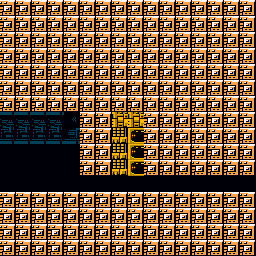
|
Located near the discarded Wily Stage found in Elec Man's Stage, it is possible to see the remains of a room from a completely unknown stage. Strangely, none of the blocks in this room have collisions.
Unused Decoration Behavior
Throughout Elec Man's stage are vacuum tubes with electrical currents (enemy type $19 (normal), $25 (delayed)) running through them. The tiles themselves are solid ground and embedded in walls besides, but if the currents are placed somewhere the player can reach them, they can hurt the player for 4 damage.
Unused Enemy Behavior
Note: The levels were modified to showcase these.
Both the Watcher enemy ($06) and Fire Storm Shooter ($0E) are coded with special spawn behavior if placed at the extreme bottom edge of a screen. They have unused functionality, however, if placed elsewhere.
Normally, a Watcher spawn placed at the bottom edge of a screen will generate two waves of six Watcher units at the left and right of the screen. If a Watcher is placed anywhere else in a level, however, it appears instantly and act as a normal enemy.
The Fire Storm Shooter in Fire Man's stage usually generates at Fire Storm every 30 frames at 201, 0 (relative to the screen), and follows a somewhat C-shaped path. If a Fire Storm Shooter is placed anywhere else in a level, it will spawn right where it was placed, then once it passes by 201, 91, it snaps to 207, 80 and continues on its usual path. Difference being, instead of having to deal with 4 Fire Storms, it will only spawn the single one.
Other enemies have weird or quirky behavior depending on where the spawn point is placed.
- Killer Bullets, Pengs, and Flying Shells all wrap around the screen from the right. If placed anywhere in a level, however, they will initially spawn right there before returning to their intended behavior.
- Any enemy that doesn't have specific instructions for spawning at the bottom edge reverts to an odd behavior where 16 of them spawn in fixed locations over 2,255 frames (35.583~ seconds).
- Curiously, the Big Eye is specifically coded not to do this and, instead, spawns two of themselves at the center-top of the screen.
Regional Differences
Title Screen
| Japan / Taiwan / China | US | Europe |
|---|---|---|

|
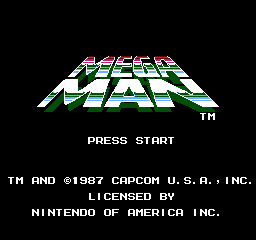
|

|
Probably the most recognizable change. Aside from the obvious complete overhaul, the American and European versions were given a logo that remained the series staple outside Japan (at least in-game, the international boxarts could never agree on a consistent logo), up until Mega Man 8.
The sound effect that plays when selecting a Robot Master also plays when pressing Start in the Japanese version, with Mega Man and the borders also flashing gray and white. The US and European versions silently flash the "PRESS START" text. While Mega Man Anniversary Collection still retains most of the international versions' changes, the title screen is no longer silent while pressing the "Start" button.
Sound Effects
In the European version of the game, two sound effects are noticeably different from their US or Japanese counterparts.
| Japan/Taiwan/China/US | Europe (60 hz) |
|---|---|
The firing sound effect for the default weapon, the Mega Buster, is supposed to play an upward-scaling set of eight notes, but in the European version, only five of these notes play while the other three are replaced by a sequence of five notes being played at the lowest possible key. The end result makes it sound like the weapon is buzzing every time it fires.
| Japan/Taiwan/China/US | Europe (60 hz) |
|---|---|
The landing sound effect also sounds quite different from the international versions. It actually bears a close similarity to the landing noise heard in the first two Game Boy games, though that might just be a coincidence.
Bizarrely, the European versions of these sounds ended up in the Rockman Complete Works version of Mega Man on the PlayStation and the version included on the PlayStation 2/GameCube/Xbox compilation, and Mega Man Anniversary Collection. Mega Man: Powered Up also uses these sounds in the intro when it's referencing this game!
Ending
| Japan / Taiwan / China | US | Europe |
|---|---|---|
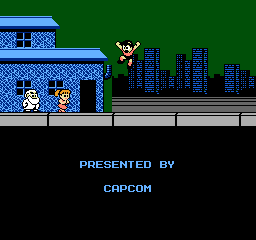
|
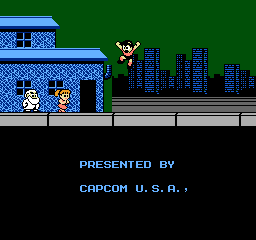
|
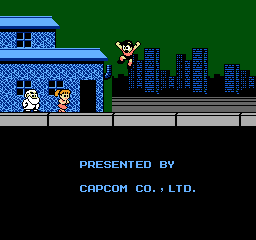
|
The "Presented by" text in the North American version contains an out of place comma due to having omitted "Inc.". The Japanese version of this text is used in Mega Man Anniversary Collection.
- Good articles
- Good main articles
- Pages missing developer references
- Games developed by Capcom
- Pages missing publisher references
- Games published by Capcom
- Games published by Ubisoft
- NES games
- FamicomBox games
- Windows games
- Pages missing date references
- Games released in 1987
- Games released in December
- Games released on December 17
- Games released on December 29
- Games with unused code
- Games with unused graphics
- Games with unused music
- Games with regional differences
- Pages with a Data Crystal link
- To do
- Mega Man series
Cleanup > Pages missing date references
Cleanup > Pages missing developer references
Cleanup > Pages missing publisher references
Cleanup > To do
Games > Games by content > Games with regional differences
Games > Games by content > Games with unused code
Games > Games by content > Games with unused graphics
Games > Games by content > Games with unused music
Games > Games by content > Pages with a Data Crystal link
Games > Games by developer > Games developed by Capcom
Games > Games by platform
Games > Games by platform
Games > Games by platform > Windows games
Games > Games by publisher > Games published by Capcom
Games > Games by publisher > Games published by Ubisoft
Games > Games by release date > Games released in 1987
Games > Games by release date > Games released in December
Games > Games by release date > Games released in December > Games released on December 17
Games > Games by release date > Games released in December > Games released on December 29
Games > Games by series > Mega Man series
The Cutting Room Floor > Good articles
The Cutting Room Floor > Good articles > Good main articles
The Cutting Room Floor > Unimportant Awards > NES games
The Cutting Room Floor > Unimportant Awards > NES games > FamicomBox games


